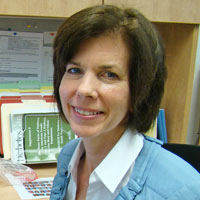Burden of diabetic ketoacidosis still unacceptably high, study finds
April 1, 2014
SEARCH for Diabetes in Youth, a multi-center, multi-ethnic study of childhood diabetes, is the largest surveillance effort of diabetes among youth under the age of 20 conducted in the United States to date. The study covers five locations across the country where about 5.5 million children live.
Elizabeth Mayer-Davis, PhD, professor and chair of the UNC Gillings School of Global Public Health’s Department of Nutrition, co-chairs the study nationally and is principal investigator for the University of North Carolina at Chapel Hill site, one of five study locations.
In a recent study, SEARCH study investigators analyzed data from 5615 youth with Type 1 diabetes and 1425 youth with Type 2 diabetes who were newly diagnosed between 2002 and 2010 to determine levels of diabetic ketoacidosis (DKA).
DKA, a life-threatening but preventable condition, remains an important problem for youth with diabetes and their families. The condition results from a severe lack of insulin. It is often the presenting symptom of Type 1 diabetes and also may be present at the onset of Type 2 diabetes.
The study, published in the April issue of the journal Pediatrics and led by Dana Dabelea, MD, PhD, professor and associate dean at the University of Colorado School of Public Health, shows that the frequency of DKA at diagnosis in U.S. youth with Type 1 diabetes did not decline over the last eight years, but remained high compared with other developed countries, with almost a third of all youth with Type 1 diabetes presenting in DKA.
Rates were disproportionately high in children younger than five years of age, non-white racial/ethnic groups, youth without private health insurance and those with lower family income. Among youth with Type 2 diabetes, DKA was much less common and decreased over time, suggesting improved detection or earlier diagnosis of diabetes.
“We know that getting to a health-care provider early on, when symptoms of Type 1 diabetes first occur, can prevent worsening of the condition leading to DKA,” said Mayer-Davis. “Especially for families in which someone already is living with Type 1 diabetes, knowing the signs and symptoms is extremely important. These include noticeable increase in frequency of urination, being very thirsty, being hungry and losing weight without trying to.”
SEARCH has estimated that there were at least 188,811 youth with diabetes in the U.S. in 2009 – 168,141 with Type 1 and 19,147 with Type 2. In the U.S. and worldwide, the incidence of Type 1 diabetes in youth has been increasing by 3 percent to 4 percent each year, with limited estimates for Type 2 diabetes except in minority populations, in which increased prevalence also has been reported.
The SEARCH study was funded by the Division of Diabetes Translation at the Centers for Disease Control and Prevention (CDC) and the National Institute of Diabetes and Digestive and Kidney Diseases (NIDDK), part of the National Institutes of Health (NIH). In addition to the University of North Carolina site, led by Mayer-Davis, and the University of Colorado site led by Dabelea, the study includes research sites in California, Ohio and Washington. The central laboratory for the study is the Northwest Lipid Research Laboratories in Seattle (Santica Marcovina, PhD, principal investigator). The coordinating center is at the Division of Public Health Sciences at Wake Forest University School of Medicine in Winston-Salem, N.C. (Ronny Bell, PhD, principal investigator).

